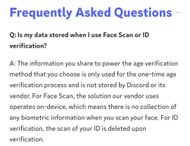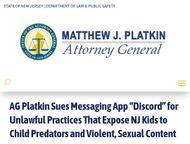Discord is testing a new age verification system that requires users to scan their faces or submit official identification to access age-restricted content.
The move marks a significant shift in the platform’s ongoing efforts to strengthen digital safety and regulatory compliance.
Discord has introduced a biometric-based age verification feature that asks users to complete a one-time facial scan or submit a valid government ID when accessing age-restricted content or attempting to change sensitive media filter settings.
The company is piloting the feature in selected markets, including the United Kingdom and Australia. When asked about this one, a Discord spokesperson said:
“We’re currently running tests in select regions to age-gate access to certain spaces or user settings.”
According to Discord, the new system is designed to better detect and prevent underage users from viewing explicit or sensitive content shared on the platform.
Users attempting to bypass sensitive content filters will be prompted to complete the verification process before gaining access.
How Discord’s age verification system works.
The new verification system offers two options. Users can either complete a facial scan using the camera on their device or scan a QR code that redirects them to a secure portal where they can upload an image of their government-issued ID.


The face scan method leverages on-device artificial intelligence to estimate the user’s age without transmitting biometric data to Discord’s servers.
For ID verification, images are deleted following confirmation of age. Discord emphasizes that neither method results in permanent data storage or third-party sharing.

The rollout is limited to specific use cases for now, including when users encounter blurred content that has been flagged as potentially inappropriate or when they attempt to turn off Discord’s sensitive content filters.
Discord’s evolving safety framework
The new face scan-based age check is the latest addition to Discord’s expanding safety toolkit.
Over the years, the platform has integrated various moderation tools, such as message scanning, auto-flagging systems, and server safety levels.
However, critics have pointed out that these mechanisms lacked enforcement, particularly concerning age-restricted access.
Until now, Discord relied on user-reported age at sign-up—a method widely considered ineffective due to its susceptibility to misinformation.
The absence of real verification meant that users under 18 could easily access NSFW channels and graphic content, often without detection. Upon this, X user @vesperamyst responded:
"why are they even allowing such content???"
The new system aims to close that gap by integrating biometric or document-based authentication, moving toward a more secure and regulated user experience.
Privacy concerns about data for Discord.
The introduction of biometric scanning has sparked privacy-related discussions across the community, some are more in favour of the age verification, where are others detest it for data breach.
An X user @nyblet said:
"Bruh verification sounds better honestly."
Meanwhile, others are pointing out the flaws in the process, an X user @neolithicobject said:
"This is actually genius, but can easil steal your data like that"
Others are straight up against it, stating one X user @explorersofai said:
"if you think this is to protect underage humans think again."
Discord has addressed these concerns by stating that the facial scans will be processed locally on users’ devices and will not be collected or stored by the company or its partners.
In the case of ID submission, images will be automatically deleted after verification.
Discord clarified that no biometric data would be retained or used beyond confirming a user’s eligibility to view sensitive content.
This approach was developed in collaboration with digital safety experts, with a focus on balancing security needs with user trust and privacy rights.
Still, many Discord users remain cautious, expressing concern over the broader implications of biometric surveillance, even when data is not stored.
Multiple Discord users should express their disdain for this feature, one X user @memeslich, the saying:
"one of the all time worst ideas ever"
Discord has reiterated that this is a limited test and will continue to collect user feedback before any global implementation.
Legal context and global regulations loom over Discord.
Discord’s decision comes amid increasing global pressure on digital platforms to tighten content control and protect younger users online.
Regulatory frameworks such as the UK’s Online Safety Act and Australia’s eSafety guidelines have prompted several major platforms to adopt stricter age-gating measures.
Additionally, lawsuits and legal investigations, including one recently filed in the United States, have criticized Discord’s age moderation practices.

They are arguing that the platform’s prior safeguards were inadequate in preventing exposure to harmful content.
Discord has positioned this new system as a proactive response to those challenges and an effort to comply with international digital safety standards.
A historical look at Discord and its moderation challenges.
Discord was initially built as a space for gamers but has since evolved into a hub for online communities spanning art, music, fandoms, education, and more.
However, as its user base expanded, so did scrutiny around safety and content regulation.The platform has previously come under fire for its lax enforcement of age-restricted content policies.
Investigations revealed that despite having filters and community guidelines in place, underage users frequently accessed NSFW servers, and moderation depended heavily on server admins.
While Discord introduced safety controls like the “Keep Me Safe” mode and content scanners, these features lacked robust backend enforcement.
With increased media attention and mounting legal concerns, the need for verifiable age controls became increasingly apparent.
What's ahead for Discord?
Discord’s experiment with face scan-based age verification may represent a defining moment in digital community safety.
If proven effective, the system could be scaled across more regions and eventually become part of Discord’s core onboarding process.
Whether other platforms will follow suit remains to be seen, but the move sets a precedent for how age-restricted content may be handled moving forward.
For now, Discord continues to monitor feedback and adjust the program based on results from its current testing environments.
